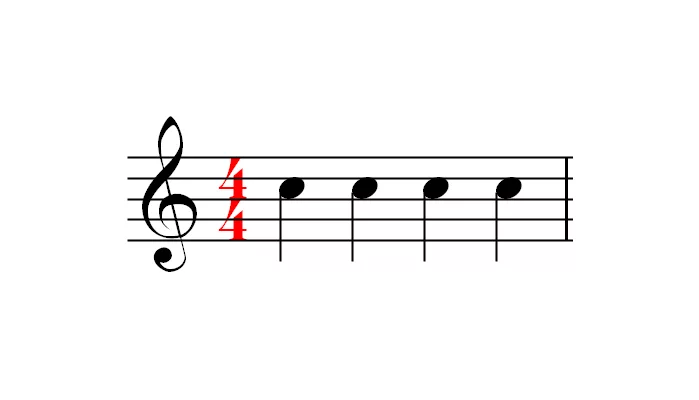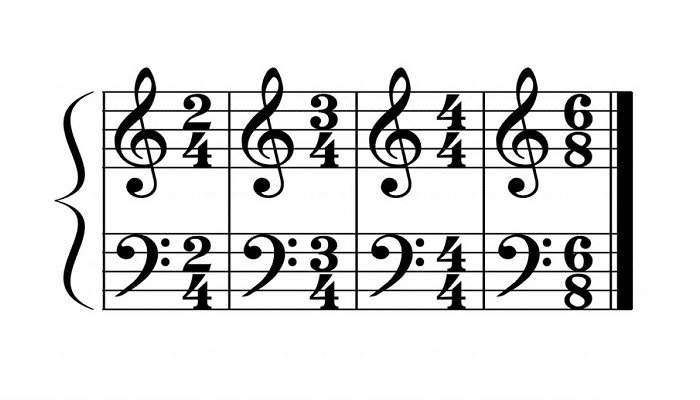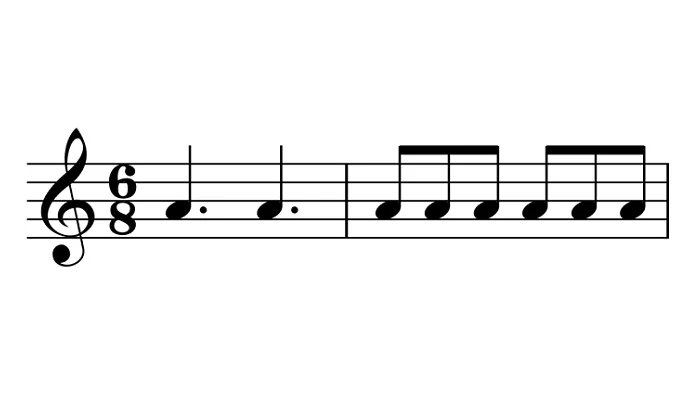Like you can’t make coffee without beans, you can’t compose rhythms without time signatures.
Time signatures are the essence of music. They dictate the beats of the song. As a result, without them, you’ll hear a flat piece of music.
The 4/4 signature is the most common in the music industry, and for all the good reasons.
If you don’t know what 4/4 means in music, follow this article for answers.
What is a Time Signature?
First things first, before exploring the 4/4 time signature, let’s see what time signatures mean in music.
Time signatures form the beats of any song. They’re written as fractions, with the top number referring to how many beats per bar and the bottom number referring to the note values.
If the bottom number is a 2, it means the beats are half notes. Meanwhile, 4 bottom numbers tell you that the beats are quarter notes, and 8 bottom numbers mean the beats are eighth notes.
So, the 4/4 time signature means you have four beats per bar. But it’s not the only one. There are a lot of other time signatures, divided into simple and compound ones.
Each group works differently. For example, compound time signatures separate music into groups of three, while simple time signatures separate it into groups of two.
On musical notes, you can find the time signature right after the key signature and the clef.
So, to summarize the meaning of time signatures in a few words, they refer to the number of counts in each measure, and they determine what note value will receive each count.
What Does 4/4 Time Signature Mean in Music?
Now that we know what time signatures are, let’s explore what the 4/4 time signature means and why it’s so unique among others.
A 4/4 signature means that there are four beats per bar, and the four on the bottom means that the note value for each beat is a crotchet. A crotchet is one beat long.
In the same sequence, a 2/4 signature indicates that there are two crotchet beats in each measure. Thus, you get the crotchet from the four in the bottom and their number from the two above.
All that said, not all musicians necessarily use crotchet notes in their music. That’s why there are other note values written in different forms, such as quavers. While crotchets are referred to with a 4, quavers are referred to with an 8 because they’re eighth notes.
So, a 3/8 time signature indicates that you’ll play three quavers in each measure. You get the quavers from the bottom 8 and their number from the 3 above.
The 4/4 time signature is the most common in the music industry because it’s used frequently in all major genres. It’s a staple in Funk, Country, Blues, Rock, and Pop music. As a result, it’s called Common Time. And, it’s often referred to using a C letter.
A List of the Common Time Signatures
The 4/4 time signature is pretty standard, but it’s not the only common time signature. There are a couple of other signatures that are also widely used in different music genres:
- 2/2
- 2/4
- 3/4
- 3/8
For one, the 2/2 time signature is the second-most common beat. It’s called Cut Time because it’s the 4/4 signature, but cut in half. It indicates that each measure includes two half beats.
When listening to it, you’ll find that it sounds almost the same as a 4/4 note, but it puts more emphasis on the third note of each bar.
On musical notes, the 2/2 time signature is often drawn as a letter C but with a vertical line passing through it. The vertical line is the only way to identify it from a 4/4 signature.
Aside from the 2/2, the 2/4 time signature is also common, mainly for marches and similar musical pieces.
On top of that, there’s the 3/4 signature, which has three beats in every bar. It has a lilting waltz sound, which is how it became so massively popular in the 19th century.
It’s used in lots of famous pieces, such as the Blue Danube Waltz by Johann Strauss. There’s also the classic Hollywood piece, Que Sera Sera.
My Favorite Things from The Sound of Music also uses the same common signature.
Lastly, one of the common time signatures is the 3/8, famously used in Beethoven’s Fur Elise.
A List of the Irregular Time Signatures
Irregular time signatures are called that way because they have an out-of-kilter effect on the listener’s year. They feel misplaced yet perfectly aligned with the rest of the song.
They’re a bit challenging to deal with because it’s not easy to fit them anywhere. On the other hand, they’re also attention-grabbing, so the musician has to think thoroughly of the best place to add an irregular time signature.
The most common irregular signature is 5/4, counted as two groups: three-quarter notes and two-quarter notes. However, some musicians also measure it in reverse, starting with the two-quarter notes and ending with the three-quarter ones.
Some musicians compose the rhythm of five quarter beats, resulting in evenly-spaced notes. Alternatively, some people opt for breaking the first two-quarter notes into four-eighth notes. Then, they compose similar second and third ones.
If you want a reference, the Mission Impossible theme by Lalo Schifrin uses this time signature.
Other irregular signatures include 7/8 and 7/4. Musicians mainly count them as a group of four, then a group of three. The same effect also happens when writing a 4/4 followed by a 3/4.
Compound Time Signatures
While both regular and irregular time signatures go under the simple classification, there are multiple other compound signatures.
In simple time signatures, musicians break the beat down into two-part rhythms. Meanwhile, with compound signatures, they break the beat into three-part rhythms. As a result, the music sounds like a one-two-three pulse.
All compound time signatures come with top numbers divisible by three, including 12/8, 6/8, and 9/4.
The most common compound signature is 6/8, which is a count of two groups of three-eighth notes. If you’re familiar with the Game of Throne’s theme opening, you’ll notice it’s composed using the 6/8.
There’s also the 9/8 signature, which is formed of three groups of three-eighth notes. It’s famously used in Bach’s Chorale, Cantata 147 – particularly in the opening.
Lastly, there’s the 12/8 signature, which forms four groups of three-eighth notes.
The thing with compound signatures is that they can be written in simple time signatures using triplets, forming groups of three.
Beethoven famously did it in the Moonlight Sonata’s opening, using triplets throughout the theme. If you write them regularly, they’ll sound exactly the same.
Can You Change Time Signatures in a Single Song?
Can you write a single song with varying time signatures?
The answer is yes; your music doesn’t have to compose of the same signature throughout. You can change it as you wish, as long as it still sounds in rhythm.
A lot of renowned composers of the 19th and the 20th century took this approach in their works. For example, Igor Stravinsky has some pieces that change signatures on every bar. You can listen to Firebird, Histoire du Soldat, and Rite of Spring for reference.
Brahms also did it frequently, going into 5/4 in the middle of a 4/4 piece. Even better, Ravel’s Piano Trio starts the first movement in 8/8, and the last movement has more than ten varying signatures. A lot of famous composers used this style in different ways.
If you want something a little bit more modern, you can check John Adams’ Short Ride in a Fast Machine. It starts with a 3/2 signature and constantly changes throughout the song.
Changing time signatures are meant to make you feel like you’re on a roller coaster. If your feelings change multiple times throughout the piece, from excitement to despair to anger, you know the musician did it right.
What’s the Difference Between Time Signatures and Beats?
Many people may get confused between beats and time signatures, although the difference is pretty simple to understand.
The beats are the central measurement unit of music. And, time signatures are beats per measure. So beats are an integral part of time signatures.
On top of that, repeating beats together creates a pulse. So, there you have the difference between beats, pulses, and signatures.
If you want to imagine what each term of these means, I’ll give you an example. Imagine you’re listening to a 4/4 song, and you’re clapping your hands along. Here, you’re clapping your hands to match the beats of the song, which form its time signatures.
Aside from the time signature, the beats also define the song’s tempo. The tempo is the speed at which the music is going, and it’s measured in beats per minute.
What Does 4/4 Mean in Music: Conclusion
Time signatures are a fundamental part of the musical language, providing the essential framework that allows rhythm, pulse, and meter to be organized, expressed, and shared between composers, performers, and listeners.
Whether driving a lively march in 2/2 or describing a lilting waltz in 3/4, time signatures allow composers to sculpt the listener’s experience, evoking specific moods and emotions through the interplay of beats.











